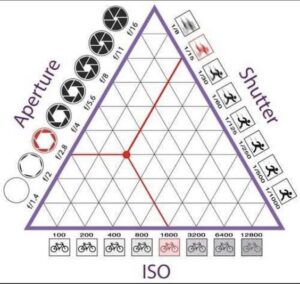The exposure triangle is a concept used in photography to describe the relationship between three factors that determine the exposure of an image: aperture, shutter speed and ISO sensitivity. These three factors interact with each other and, if changed, can affect the exposure of the final image.
Aperture refers to the size of the lens opening, which controls the amount of light entering the camera. It is expressed in terms of a number and can range from f/1.4 to f/22 (depending on the lens). The smaller the f-number, the larger the aperture and the more light entering the camera.
Exposure time refers to how long the camera sensor is exposed to light. It is expressed in seconds or fractions of a second and can vary from 1/8000th of a second to several hours. The longer the exposure time, the more light enters the camera.
ISO sensitivity refers to the sensor’s sensitivity to light. It is expressed in ISO numbers which can range from ISO 100 to ISO 6400 or even higher (depending on the camera model). The higher the ISO value, the more sensitive the sensor is to light.
The exposure triangle describes the relationship between these three factors: every change in one of them affects the exposure of the final image. For example, if you increase the aperture, you must compensate by reducing the exposure time or ISO sensitivity to avoid an overexposed image. Conversely, if you reduce the aperture, you must compensate by increasing the exposure time or ISO sensitivity to avoid an underexposed image. In this way, any variation of the exposure triangle can be compensated for to obtain the correct exposure.
The exposure triangle is a vital tool for getting properly exposed images in photography. To use it effectively, you need to understand the relationship between the three factors that make it up: aperture, exposure time and ISO sensitivity.
In practice, to use the exposure triangle, you need to set the aperture values, exposure time and ISO sensitivity in order to obtain the desired exposure. For example, if you wanted to get a properly exposed image in a low light situation, you could set the aperture to a small value (e.g. f/2.8), increase the exposure time (e.g. 1/60 second) and increase the ISO sensitivity (such as ISO 1600). Conversely, if you want to get a sharp image with a large depth of field in a bright light situation, you could set a large aperture (e.g. f/11), a shorter exposure time ( such as 1/250 second) and a lower ISO sensitivity (such as ISO 100).
In any case, it is important to remember that any variation of one of the three factors of the exposure triangle must be compensated for by the variation of at least one of the other two factors in order to maintain the correct exposure of the image. The choice of aperture values, exposure time and ISO sensitivity depends on the creative needs of the photographer and on the light conditions in which you are shooting.
We are waiting for you on our page FACEBOOK !!!
